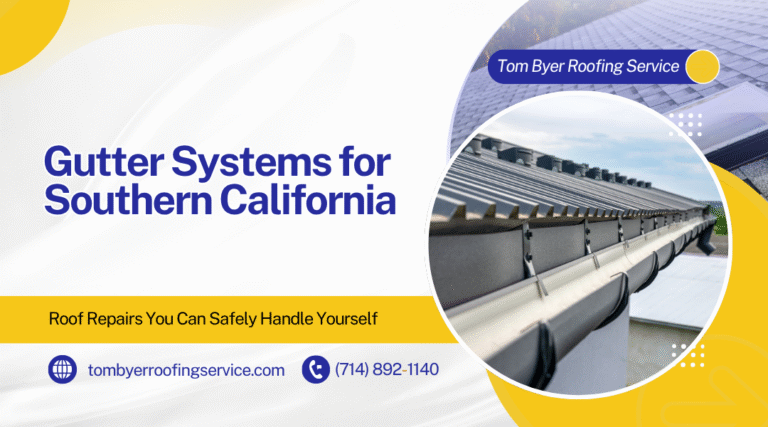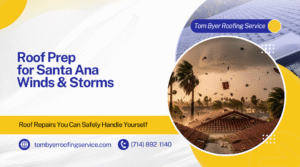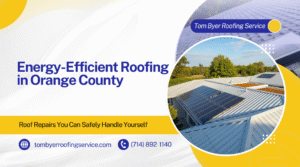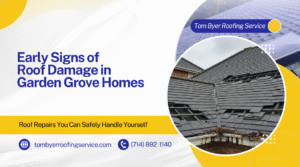Southern California’s unique climate presents homeowners with distinct challenges when selecting effective gutter systems. The region experiences both intense dry seasons that can cause materials to crack and expand, and sudden wet seasons with heavy rainfall that can overwhelm inadequate drainage systems.
The most effective gutter systems for Southern California homes combine durable materials like aluminum or steel with proper sizing and strategic placement to handle both seasonal extremes. Different gutter types, materials, and configurations perform better depending on specific local conditions, roof design, and precipitation patterns throughout Garden Grove and surrounding areas.
Selecting the right gutter system involves understanding how climate impacts performance, exploring various system types and beneficial add-ons, and implementing proper maintenance practices. Tom Byer Roofing Service brings decades of experience helping property owners choose and maintain gutter solutions that protect their investments year-round.
Climate And Its Impact On Gutters
Southern California’s unique climate creates distinct challenges for gutter systems throughout the year. The region’s dramatic shift between bone-dry conditions and intense seasonal rainfall demands specialized considerations that standard gutter installations often fail to address.
Dry Season Hazards
Extended dry periods lasting 6-8 months expose gutters to intense UV radiation and extreme temperature fluctuations. Daily temperature swings can reach 40-50 degrees, causing materials to expand and contract repeatedly.
UV Damage becomes severe during Southern California’s cloudless summer months. Vinyl gutters crack and become brittle within 3-5 years of installation. Standard aluminum gutters fade and develop chalk-like residue without protective coatings.
Debris Accumulation intensifies during dry seasons as dead vegetation, dust, and fire ash collect in gutter channels. Santa Ana winds deposit large volumes of leaves and debris that create blockages before the first rains arrive.
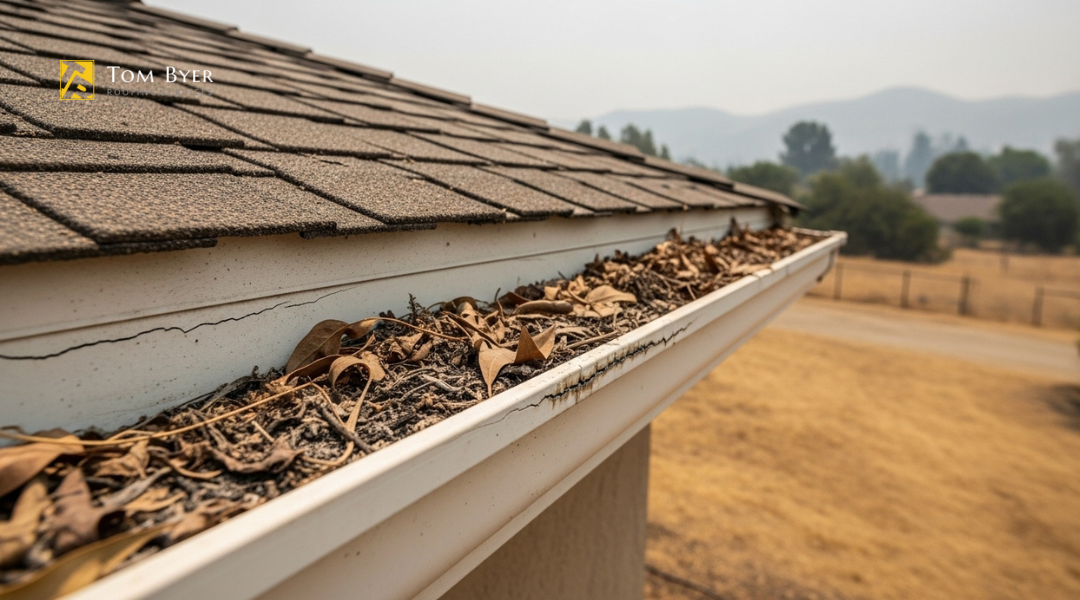
Thermal Stress affects gutter joints and connections. Morning temperatures of 50°F can climb to 100°F by afternoon, causing expansion gaps to widen and fasteners to loosen. Metal gutters without proper expansion joints develop stress cracks at connection points.
Fire-prone areas face additional risks from ember accumulation in gutters during wildfire season. Dry debris becomes kindling that can ignite roof structures.
Wet Season Challenges
Southern California’s concentrated rainfall patterns overwhelm inadequate gutter systems during brief but intense storm periods. The region receives 75% of annual precipitation between November and March in sudden downpours rather than steady rainfall.
Flash Flooding Events produce rainfall rates of 2-4 inches per hour during atmospheric rivers. Standard 5-inch gutters cannot handle these volumes, causing overflow that damages foundations and landscaping.
Temperature Shock occurs when cold winter rains contact sun-heated gutters. Rapid cooling causes metal gutters to contract quickly, stressing joints and creating leaks at seams.
Debris Blockages become critical during first rains after dry months. Accumulated leaves and sediment form dams that force water over gutter edges. Clogged downspouts create backup conditions that damage fascia boards.
Winter storms bring sustained winds that test gutter attachment strength. Inadequately supported systems pull away from rooflines under water weight and wind pressure.
Why One-Size-Fits-All Gutters Don’t Work Here
Southern California’s extreme seasonal variations require specialized gutter solutions that standard installations cannot provide. Generic systems designed for moderate climates fail within 2-3 years under local conditions.
Material Selection becomes critical for climate survival. Vinyl gutters crack during temperature extremes while basic aluminum corrodes from salt air in coastal areas. Copper and heavy-gauge aluminum with protective coatings perform better but require higher initial investment.
Size Requirements differ dramatically from national standards. Six-inch gutters with oversized downspouts handle sudden rainfall better than standard 5-inch systems. Coastal mountain areas need even larger capacity due to orographic rainfall effects.
Installation Methods must accommodate thermal movement and seismic activity. Flexible connections and proper spacing of hangers prevent stress failures during temperature changes and minor earthquakes.
Regional microclimates create additional complications. Desert-adjacent areas need maximum UV protection while coastal zones require corrosion-resistant materials for salt air exposure.
Top Gutter System Types For Southern California Homes And Businesses
Southern California properties benefit most from seamless aluminum systems that handle both dry periods and seasonal rainfall. Commercial buildings often require larger box gutters, while residential homes can choose between traditional K-style and decorative half-round designs based on architectural needs.
Seamless Aluminum Gutters
Seamless aluminum gutters perform exceptionally well in Southern California’s climate. These systems resist corrosion from coastal salt air and handle temperature fluctuations without cracking.
The seamless design eliminates joints where debris typically accumulates. This reduces maintenance needs during dry seasons when leaves and dust collect in gutter systems.
Key Benefits:
- Durability: 20-30 year lifespan in coastal climates
- Low maintenance: Fewer clogs and leaks
- Cost-effective: Mid-range pricing with excellent value
- Color options: Over 30 colors available for aesthetic matching
Aluminum gutters expand and contract minimally compared to steel alternatives. This stability prevents warping during Southern California’s hot summer months.
Professional installation ensures proper slope calculation for effective water flow. Tom Byer Roofing Service recommends 5-inch gutters for most residential applications to handle sudden downpours.
Copper Gutters
Copper gutters offer premium performance and distinctive appearance for upscale properties. The material develops a natural patina that protects against corrosion in marine environments.
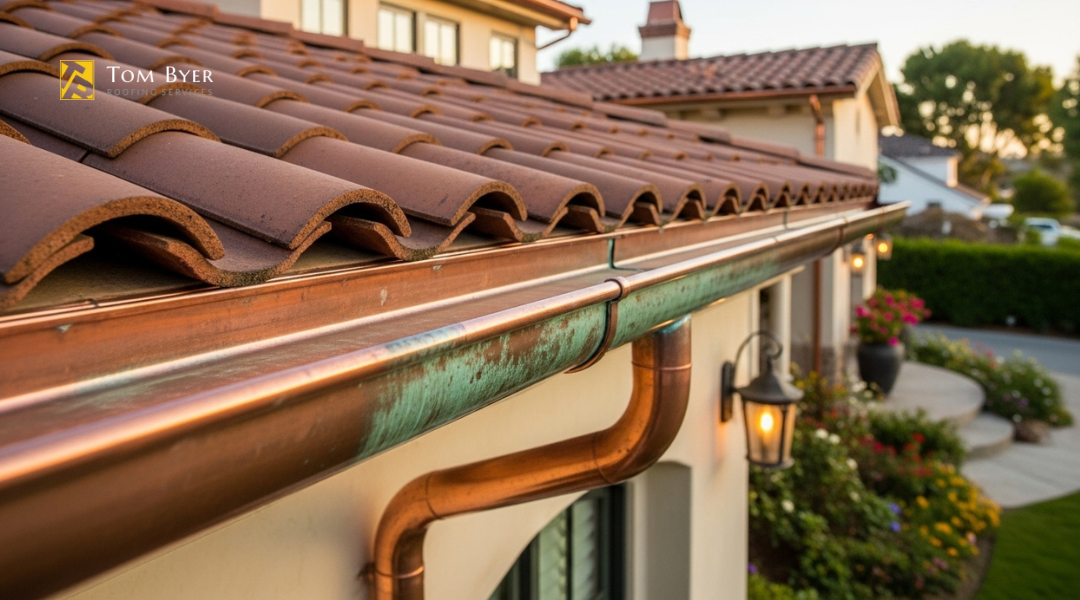
These systems last 50-100 years with minimal maintenance requirements. Copper naturally resists algae and moss growth during wet seasons.
Installation Considerations:
- Higher upfront investment than aluminum
- Requires experienced installers familiar with soldering techniques
- Compatible with tile and slate roofing common in Southern California
- Thermal expansion requires proper joint spacing
The material’s antimicrobial properties prevent bacterial growth in standing water. This benefit proves valuable during extended dry periods when small amounts of water may remain in gutters.
Copper gutters complement Spanish Colonial and Mediterranean architectural styles prevalent throughout the region. The aging process creates unique coloration that enhances property value.
Box Gutters For Commercial Properties
Commercial buildings require box gutters to manage large roof areas and heavy water volumes. These rectangular systems integrate into roof structures for improved capacity.
Box gutters handle 2-3 times more water than residential K-style systems. This capacity proves essential for warehouses, office buildings, and retail centers with expansive flat roofs.
Design Specifications:
- Width: 8-12 inches typical for commercial applications
- Depth: 4-6 inches for adequate flow capacity
- Materials: Galvanized steel or aluminum construction
- Outlets: Multiple downspouts prevent overflow
Professional installation requires precise slope calculations and waterproof membrane integration. Improper installation leads to ponding water and structural damage.
Regular inspection prevents debris accumulation that blocks drainage outlets. Commercial properties should schedule quarterly cleanings to maintain optimal performance.
Half-Round Vs. K-Style Gutters
K-style gutters feature flat backs and decorative fronts resembling crown molding. This design provides 20% more water capacity than equivalent half-round systems.
Half-round gutters offer traditional aesthetics suited for historic properties and custom homes. The curved shape promotes better water flow and reduces debris retention.
| Feature | K-Style | Half-Round |
|---|---|---|
| Capacity | Higher | Moderate |
| Cost | Lower | Higher |
| Aesthetics | Modern | Traditional |
| Maintenance | More frequent | Less frequent |
K-style gutters work well for tract homes and modern construction throughout Orange County. The increased capacity handles sudden rainfall from Pacific storm systems.
Half-round gutters suit Spanish Revival and Craftsman homes common in established neighborhoods. These systems require custom brackets and specialized installation techniques.
Both styles perform adequately in Southern California’s moderate climate. The choice depends on architectural preferences, budget constraints, and desired maintenance levels.
Add-Ons That Improve Gutter Performance Year-Round
Strategic gutter add-ons prevent debris buildup during dry months and manage heavy water flow during Southern California’s rainy season. These accessories reduce maintenance requirements while protecting homes from both overflow damage and clogging issues.
Gutter Guards And Leaf Screens
Gutter guards block leaves, twigs, and debris from entering the gutter system while allowing water to flow freely. This protection becomes essential during Southern California’s dry season when palm fronds, eucalyptus leaves, and other debris accumulate.
Micro-mesh guards feature fine screens that filter out small particles while maintaining water flow. They work effectively with light rainfall and heavy downpours common in the region.
Reverse curve systems direct water into gutters while deflecting debris over the edge. These guards handle varying water volumes well during seasonal transitions.
Foam inserts fit directly inside gutters and allow water penetration while blocking larger debris. They require replacement every few years but offer affordable protection.
Guards reduce cleaning frequency from multiple times per year to once annually. They prevent clogs that cause water overflow and potential foundation damage during intense winter storms.
Splash Blocks And Downspout Extensions
Splash blocks direct water away from foundation walls and prevent soil erosion around the home’s base. They become particularly important during Southern California’s wet season when concentrated rainfall creates significant runoff.
Concrete splash blocks provide durable water redirection and resist cracking in dry conditions. They handle high-volume water discharge without shifting position.
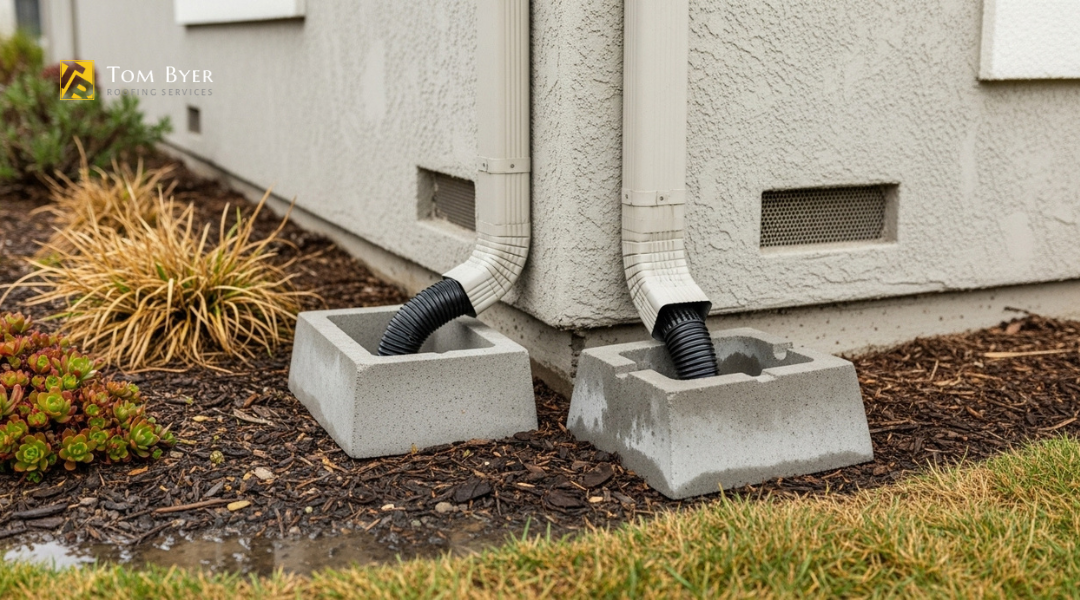
Plastic splash blocks offer lightweight installation and various color options to match landscaping. They work well for moderate water flow situations.
Flexible downspout extensions carry water 3-6 feet from the foundation. They can be adjusted seasonally and stored during dry periods when appearance matters more.
Extensions prevent water pooling near foundations and protect drought-stressed landscaping from erosive water flow. They direct runoff to appropriate drainage areas or garden zones.
Rain Chains And Decorative Downspouts
Rain chains replace traditional downspouts with linked metal chains or decorative cups that guide water downward. They function effectively in Southern California’s moderate climate while adding visual appeal to home exteriors.
Cup-style chains collect and release water in controlled amounts, creating attractive water features during rainfall. They handle moderate to heavy water flow without splashing.
Link chains provide simple water guidance and work best with lighter rainfall amounts. They create gentle water sounds and interesting visual elements.
Decorative downspouts combine function with architectural style through materials like copper, aluminum, or powder-coated steel. They resist corrosion in coastal areas and maintain appearance in dry conditions.
Rain chains require splash basins or decorative pots at ground level to prevent erosion. They work best on homes with covered porches or areas where water sounds enhance outdoor spaces.
Gutter Maintenance Best Practices For Garden Grove And Surrounding Areas
Garden Grove homeowners need consistent maintenance schedules that account for both dry debris accumulation and heavy rain seasons. Recognizing early warning signs prevents costly water damage while understanding professional service limitations helps determine when expert intervention becomes necessary.
Seasonal Maintenance Schedule
Garden Grove’s climate requires a dual-season approach to gutter maintenance. Property owners should clean gutters twice yearly: once in late spring after Santa Ana winds deposit debris, and again in early fall before winter rains begin.
Spring maintenance focuses on removing accumulated dust, leaves, and wind-blown debris. The dry season allows debris to compact in gutters, creating blockages that prevent proper water flow during unexpected storms.
Fall preparation becomes critical before November through March rain seasons. Homeowners should inspect all connections, test drainage capacity, and clear downspouts completely.
Monthly visual inspections help identify problems between major cleanings. Property owners should check for standing water, sagging sections, or debris buildup after windstorms.
Garden Grove’s occasional heavy downpours can overwhelm neglected systems. Regular maintenance prevents water overflow that damages foundations, landscaping, and exterior walls.
Warning Signs Your Gutter System Needs Attention
Several indicators signal immediate gutter maintenance needs in Garden Grove properties. Water staining on exterior walls shows overflow problems that require prompt attention.
Sagging gutter sections indicate hardware failure or excessive debris weight. These issues worsen quickly during rain events and can cause complete system failure.
Plant growth in gutters signals chronic moisture retention and poor drainage. Seeds germinate in accumulated organic matter, creating root systems that damage gutter materials.
Basement moisture or foundation water marks often trace back to failing gutter systems. Poor drainage directs water toward structures instead of away from foundations.
Pest activity increases around clogged gutters where standing water attracts insects and provides nesting materials for birds. These problems multiply without intervention.
Why DIY Cleanouts Aren’t Always Enough
Garden Grove homeowners often underestimate gutter system complexity and safety requirements. Professional assessment identifies structural issues that basic cleaning cannot address.
Ladder safety poses significant risks for multi-story properties common in Garden Grove. Professional technicians use appropriate equipment and follow safety protocols that prevent accidents.
Hidden damage like loose fasteners, improper pitch, or damaged flashing requires specialized knowledge to diagnose correctly. DIY efforts may miss these critical issues.
Downspout connections and underground drainage systems need professional tools for proper cleaning. Homeowners typically cannot access or clear these components effectively.
Insurance considerations favor professional maintenance for liability protection. Documented professional service provides coverage advantages that DIY maintenance cannot match.
Why Work With Tom Byer Roofing Service For Gutter Installations And Repairs
Tom Byer Roofing Service brings decades of experience and local expertise to gutter projects throughout Orange County. Their comprehensive approach combines specialized knowledge of Southern California weather patterns with full-service roofing and drainage solutions.
Locally Trusted And Family-Owned Since 1952
Tom Byer Roofing Service has operated as a family-owned business for over 70 years. The company established its reputation in 1952 and has maintained consistent service throughout multiple generations of Southern California homeowners.
This longevity demonstrates their ability to adapt to changing roofing technologies and weather patterns. Local contractors understand the specific challenges that Orange County properties face during both dry and wet seasons.
The company has built relationships with suppliers and developed installation techniques specifically suited to the region’s climate. Their experience spans residential homes, commercial buildings, industrial facilities, and apartment complexes.
Key advantages of their established presence:
- Deep understanding of local building codes
- Relationships with regional suppliers
- Knowledge of common property-specific issues
- Proven track record across different property types
Custom Solutions For Homes And Commercial Buildings
Tom Byer Roofing Service designs gutter systems based on individual property requirements. They assess factors like roof size, slope, rainfall patterns, and existing drainage infrastructure before recommending specific solutions.
Commercial properties often require larger capacity gutters and more complex drainage planning. The company handles both residential and commercial projects with appropriate sizing and materials for each application.
Their team evaluates how gutters integrate with existing roofing materials and architectural features. This approach ensures proper water flow and prevents issues like pooling or overflow during heavy rainfall.
Custom considerations include:
- Building height and roof complexity
- Local drainage requirements
- Material compatibility with existing systems
- Maintenance accessibility
Full-Service Approach: Roofing + Gutters + Drainage Planning
The company provides integrated solutions that address roofing, gutters, and overall drainage as connected systems. This comprehensive approach prevents common problems that occur when these elements are planned separately.
Their technicians understand how gutter placement affects roof performance and building protection. They coordinate installations to ensure proper water flow from roof surfaces through gutters to appropriate drainage points.
This full-service model allows for better project coordination and quality control. Clients work with one contractor for multiple related services rather than coordinating between different specialists.
The team can identify potential issues early in the planning process. They address compatibility between different system components before installation begins.
Serving Garden Grove And All Of Orange County
Tom Byer Roofing Service operates throughout Orange County from their Garden Grove location. Their service area includes both coastal and inland communities with different climate considerations.
The company maintains local availability for both emergency repairs and scheduled maintenance. They understand the variations in weather patterns across different parts of Orange County.
Service coverage includes:
- Garden Grove and surrounding cities
- Coastal areas with salt air exposure
- Inland regions with temperature extremes
- Commercial districts and residential neighborhoods
Their local presence enables faster response times for urgent gutter repairs. The team can quickly assess storm damage or blockages that require immediate attention.

